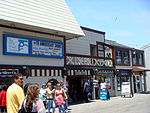Monterey station

Monterey station was a train station in Monterey, California located close to Fisherman's Wharf. Originally served by the Monterey & Salinas Valley Railroad, the line was purchased by Southern Pacific on September 29, 1879. Southern Pacific constructed a new station building in 1921. Train service ended with the cancellation of the Del Monte after April 30, 1971, when Amtrak took over passenger rail services in the United States. The depot was converted to retail space, and is occupied by a brewpub as of 2019. Restoration of service along the Monterey Branch Line was studied in the 1984-89 Caltrans passenger rail development plan. Later suggestions call for establishment of light rail service along the Monterey Branch Line, but the Monterey stop is planned to be located at the Custom House Plaza.
Excerpt from the Wikipedia article Monterey station (License: CC BY-SA 3.0, Authors, Images).Monterey station
Figueroa Street, Monterey
Geographical coordinates (GPS) Address Website Nearby Places Show on map
Geographical coordinates (GPS)
| Latitude | Longitude |
|---|---|
| N 36.601163 ° | E -121.891282 ° |
Address
Dust Bowl Brewing Company Tap Depot
Figueroa Street 290
93940 Monterey
California, United States
Open on Google Maps








